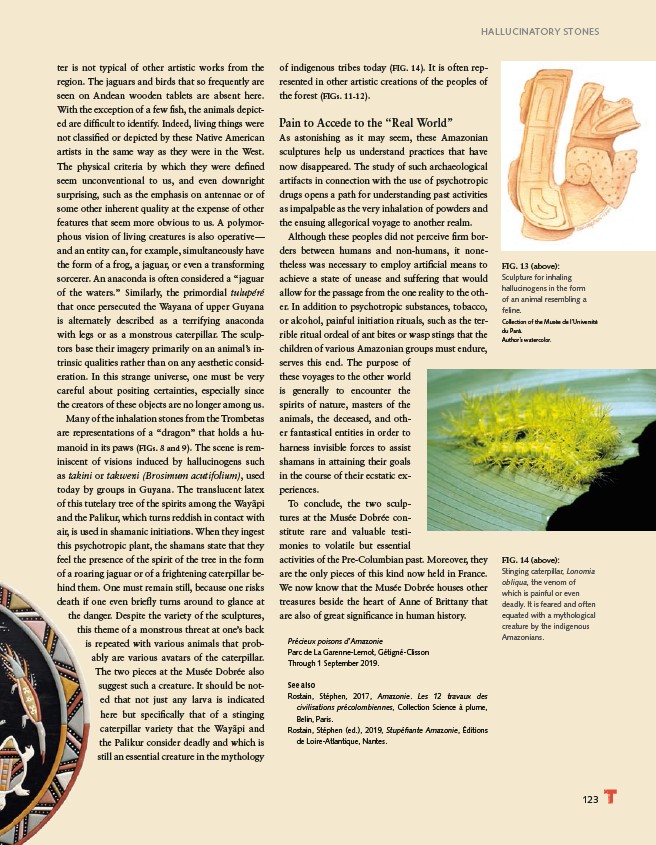
HALLUCINATORY STONES
123
ter is not typical of other artistic works from the
region. The jaguars and birds that so frequently are
seen on Andean wooden tablets are absent here.
With the exception of a few fish, the animals depicted
are difficult to identify. Indeed, living things were
not classified or depicted by these Native American
artists in the same way as they were in the West.
The physical criteria by which they were defined
seem unconventional to us, and even downright
surprising, such as the emphasis on antennae or of
some other inherent quality at the expense of other
features that seem more obvious to us. A polymorphous
vision of living creatures is also operative—
and an entity can, for example, simultaneously have
the form of a frog, a jaguar, or even a transforming
sorcerer. An anaconda is often considered a “jaguar
of the waters.” Similarly, the primordial tulupéré
that once persecuted the Wayana of upper Guyana
is alternately described as a terrifying anaconda
with legs or as a monstrous caterpillar. The sculptors
base their imagery primarily on an animal’s intrinsic
qualities rather than on any aesthetic consideration.
In this strange universe, one must be very
careful about positing certainties, especially since
the creators of these objects are no longer among us.
Many of the inhalation stones from the Trombetas
are representations of a “dragon” that holds a humanoid
in its paws (FIGs. 8 and 9). The scene is reminiscent
of visions induced by hallucinogens such
as takini or takweni (Brosimum acutifolium), used
today by groups in Guyana. The translucent latex
of this tutelary tree of the spirits among the Wayãpi
and the Palikur, which turns reddish in contact with
air, is used in shamanic initiations. When they ingest
this psychotropic plant, the shamans state that they
feel the presence of the spirit of the tree in the form
of a roaring jaguar or of a frightening caterpillar behind
them. One must remain still, because one risks
death if one even briefly turns around to glance at
the danger. Despite the variety of the sculptures,
this theme of a monstrous threat at one’s back
is repeated with various animals that probably
are various avatars of the caterpillar.
The two pieces at the Musée Dobrée also
suggest such a creature. It should be noted
that not just any larva is indicated
here but specifically that of a stinging
caterpillar variety that the Wayãpi and
the Palikur consider deadly and which is
still an essential creature in the mythology
of indigenous tribes today (FIG. 14). It is often represented
in other artistic creations of the peoples of
the forest (FIGs. 11-12).
Pain to Accede to the “Real World”
As astonishing as it may seem, these Amazonian
sculptures help us understand practices that have
now disappeared. The study of such archaeological
artifacts in connection with the use of psychotropic
drugs opens a path for understanding past activities
as impalpable as the very inhalation of powders and
the ensuing allegorical voyage to another realm.
Although these peoples did not perceive firm borders
between humans and non-humans, it nonetheless
was necessary to employ artificial means to
achieve a state of unease and suffering that would
allow for the passage from the one reality to the other.
In addition to psychotropic substances, tobacco,
or alcohol, painful initiation rituals, such as the terrible
ritual ordeal of ant bites or wasp stings that the
children of various Amazonian groups must endure,
serves this end. The purpose of
these voyages to the other world
is generally to encounter the
spirits of nature, masters of the
animals, the deceased, and other
fantastical entities in order to
harness invisible forces to assist
shamans in attaining their goals
in the course of their ecstatic experiences.
To conclude, the two sculptures
at the Musée Dobrée constitute
rare and valuable testimonies
to volatile but essential
activities of the Pre-Columbian past. Moreover, they
are the only pieces of this kind now held in France.
We now know that the Musée Dobrée houses other
treasures beside the heart of Anne of Brittany that
are also of great significance in human history.
Précieux poisons d’Amazonie
Parc de La Garenne-Lemot, Gétigné-Clisson
Through 1 September 2019.
See also
Rostain, Stéphen, 2017, Amazonie. Les 12 travaux des
civilisations précolombiennes, Collection Science à plume,
Belin, Paris.
Rostain, Stéphen (ed.), 2019, Stupéfiante Amazonie, Éditions
de Loire-Atlantique, Nantes.
FIG. 13 (above):
Sculpture for inhaling
hallucinogens in the form
of an animal resembling a
feline.
Collection of the Musée de l’Université
du Pará.
Author’s watercolor.
FIG. 14 (above):
Stinging caterpillar, Lonomia
obliqua, the venom of
which is painful or even
deadly. It is feared and often
equated with a mythological
creature by the indigenous
Amazonians.